↑ ↓ ↑ ↓
RON MOORE INTERVIEWS RON BLOORE
Hamilton Community Television c.1988
The Peel Museum has done us a great service by posting on line this interview between Bloore and his long-time dealer Ron Moore which originally appeared on Hamilton community television. It has all the usual hall marks of a Bloore interview, pleasant and otherwise, most of them to an unusual extent. It is clear that the traditional few drinks beforehand just to relax were extended in this instance, perhaps by some delay in setting up or something of the sort. A few extra drinks seem to have been relied upon to extend relaxedness through some such unforeseen frustration.
Difficult to understand at the best of times due to his tendency to lower his voice for effect, Bloore here frequently dips below audibility. Also, as I have pointed out before, he always took as artistic an approach to speaking as he did to painting, and this includes a predilection for being difficult, even cryptic in addition to being surprising and amusing.
This disinhibition from drink in a way makes the video somewhat endearing, however, it renders the auto-generated transcript virtually useless.
↑ ↓ ↑ ↓
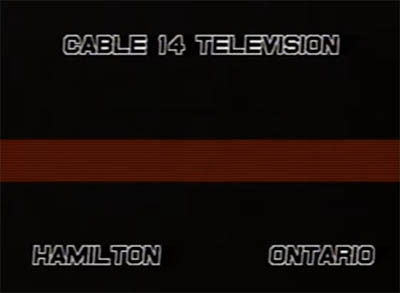 |
 |
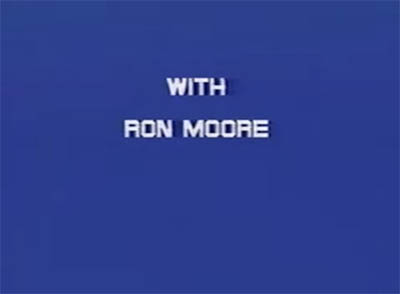 |
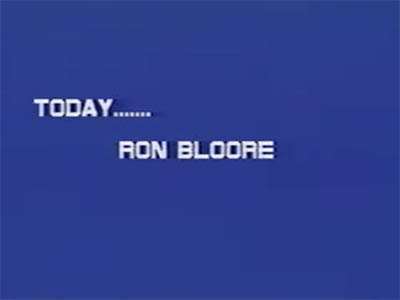 |
R. M. - - I'm Ron Moore of the Moore Gallery in Hamilton's Hess Village, and we're in our gallery this afternoon to spend a half an hour with one of Canada's most important painters, Ronald Bloore. I think you'll find the interview very interesting. Ron Bloore has traveled and taught art and has had a very interesting career.
And this is Ronald Bloore beside me. We'll spend half an hour and talk to him about his career as a Canadian artist.
↑ ↓ ↑ ↓
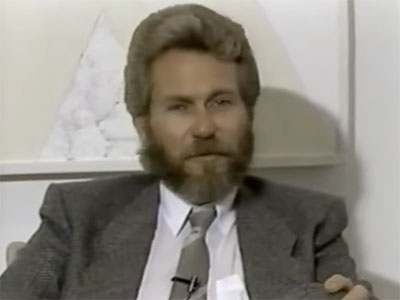 |
 |
Okay what I'd like to do Ron is, I'd like to spend some time talking about your life. Of course I know you were born in Brampton in 1925. You tell me that at the young age of four and a half years old you were already thinking about being an artist. Maybe... let's just spend a little time talking about your schooling and the early years.
R. B. - - Good Lord yes. It's at four, about four and a half, I don’t… Yes, I do remember exactly why I thought I'd become an artist.
↑ ↓ ↑ ↓
And I was drawing away, and the Canada Bread man said to my mother, “Is he gonna be an artist?” She said, “Oh, no no no!”
I was doing some drawing at the kitchen table. I remember I was facing south. And the Canada Bread man came to the door. They used to have a Canada Bread man coming around the door. Porcelain cart, that sort of thing, right? And I was drawing away and the Canada Bread man said to my mother, “Is he gonna be an artist?” She said, “Oh, no no no! There's no money in that.” By God, that convinced me I was going to be an artist! I mean, that helped me very nicely along the way. Yeah.
But there wasn't much. I didn't even know what it was! I'd never seen a painting in my life. What four and a half year old kid has in a small town like Brampton? But somehow or other it was in my head that people did do paintings, works of art. I probably didn't see anything decent for many years thereafter although I do recall as a public school kid saving up my nickels and dimes and quarters. I would take the bus, the Grey Coach down from Brampton to Avenue Road and Bloor Street and getting off and going into the Royal Ontario Museum. That was a nice big deal to be able to do that for the day. Also it got me out of the house for the day and away from my parents for the day…
↑ ↓ ↑ ↓
 |
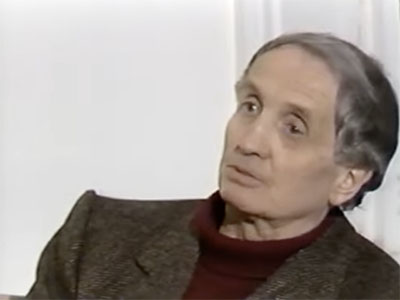 |
R. M. - - So you were interested at a real early age, and really your parents weren't the driving force behind it. It was just something that you really wanted to do.
R. B. - - It would be a driving force in the negative sense, that is, that very peculiar things would happen. I knew that there were art lessons being given at the Art Gallery of Toronto, as it was known then. I remember they took me down one Saturday to see about it. And I thought, this is very nice. But nothing ever happened about the whole thing. Maybe my father felt it was a bit much to drive down to Toronto - you know in the ’30’s - every Saturday just so I could take some art lessons. Maybe, I don't know.
I remember they took me in one time to buy some oil paints. My God, I can still remember the first oil painting I ever did - terrible! I didn't know. I didn't know! How do you know about these things? I mean, for me, sometimes if I think back - I don't like to be bothered wasting my time thinking back - how does one decide what one's going to do, sometime or other, without any direct experience with material?
Except I'll say this much: the high school, Brampton High School, I went to was filled up with a bunch of paintings from floor to ceiling. You couldn't have stuff like that in a high school anymore. It was the Perkins Bull collection. You have big paintings by George Reid and George Thompson, the brother of Tom Thompson. I mean, Perkins Bull really collected the world's worst. But nevertheless, there were paintings everywhere in that high school, in the corridors. And so in high school I was well aware that paintings came in great big nice guilt frames. And there were marvellous things that could be taking place within them. That was possibly a fairly good influence.
R. M. - - That was the early start and then you left High School.
R. B. - - To get out of high school I joined [tried to join] the Royal Canadian Air Force, the only way I could get out. [However] you couldn't die for your country without your grade 13 you know. So this is how I got out: Another guy and I, we fought it out to be bottom of class. I failed: I came in second from the bottom of the class. My colleague who beat me by being the worst in the class ended up with a PhD from Harvard in Forestry.
So as a teacher I've never paid any particular attention to the high school record of any student coming in to me at University. Totally irrelevant. Because maybe once you go to university you've got a drive. You know what you want to do! You don't have to take too many irrelevant things. And you go for it! You're free at last.
R. M. - - Right. You're concentrating on things that are important. You were in the U of T from 1945 to 1949. Talk a little bit about that. You started studying art history. You spent a lot of time, a lot of years, studying that.
R. B. - - All my studying has been art history. I am self-taught as a painter. Everyone should say that. I mean you don't have to go to school to learn how to paint, I suppose. The U of T experience 45-49 getting a BA was marvellous. Good experience. It was on the Department of Veterans Affairs. Everything was paid for, helping sixty dollars a month. Very nice. But then I'd saved up money from summer work and other work you get during the school year. And it was marvellous.
R. M. - - And then on to New York.
R. B. - - And on to New York to pursue more art history at the Institute of Fine Arts NYU until I ran out of money there. And that was good. It was good, really intense, German-American art history training. You researched everything. You found out everything you could about something before you said anything or wrote a word about it. Quite different from other traditions in art history.
And I ran out of money there. So I got a grad assistantship and went to Washington University in St Louis. And I must confess that I hadn't really thought about St. Louis. I thought Washington University would be in the state of Washington. I wondered how I could make enough money [that summer] to get from Toronto to Washington University and the state of Washington. Fortunately it turned out to be in St Louis and I could solve that distance problem. It wasn't so great.
And I spent a couple years there. Got my MA. The problem was I was switching around a little bit. My studies were all generalized. Working graduate work you have to begin to concentrate, major and minor, that sort of thing. I had been doing a lot of work in Chinese archaeology, and then decided: well, there's no point in pursuing that because at that point it seemed like no Westerner could get into China to do any particular work there.
↑ ↓ ↑ ↓
I went to England to study with the now notorious Sir Anthony Blunt...
So later I went to England to study with the now notorious Sir Anthony Blunt. 17th century French painting. But I'm afraid the only thing he liked about me were the pretty buttons on the red viyella shirt I had one time. One learns to keep one's distance. [Cf: The Murray Interview, 1978.]
R. M. - - So you've moved around. You’ve studied in Canada. For a while you were then in New York. And now, you were in Europe. So you've got to see quite a bit. At the same time as you were concentrating on art history.
R. B. - - Spent a summer in Belgium, Brussels, Antwerp. Studying the works of Rubens - marvellous, great, voluptuous nudes, day-in and day-out. Gorgeous. Marvellous.
R. M. - - That has nothing to do with, of course, the paintings that you're painting today.
R. B. - - Well I don't think we'll get into that one right now!
↑ ↓ ↑ ↓
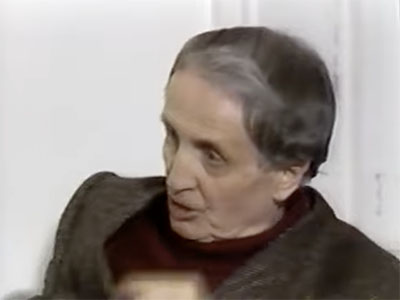 |
 |
R. M. - - We spent a bit of time talking, before we did this interview. And you were talking about the importance of travel. Maybe you could spend some time telling us about the travel and how it's affected you and your painting and how important it has been to you as an artist.
R. B. - - We could have made, fundamentally, the point of travel now is, to simply see works of quality. They have to have touched the bases, as it were, of quality. Living in Toronto? I mean, what are your chances of seeing anything of any great quality? I mean, world-class quality, to use a terrible expression.
I love to go to Chartres Cathedral. It took me a long time to understand Hagia Sophia, in Istanbul. It's marvellous there. We had a hotel in the Old City of Istanbul and every time I went for a pee in that broken down hotel I was looking out over the rooftops and there, I could see Hagia Sofia in front of me. And it dawned on me one day what was so really great about it.
Other times I've been off to Iran, and just places, obvious places like Persepolis, Behestan, Hamedan, Nag Hammadi in Egypt.
↑ ↓ ↑ ↓
And also too, in Iran, to see: what truly is the most beautiful city - was at least the most beautiful city in the world, I think - the 17th century city of Isfahan.
And also too, in Iran, to see: what truly is the most beautiful city - was at least the most beautiful city in the world, I think - the 17th century city of Isfahan. I know the Iraqis sent some missiles there. I hope they missed or fell short or something. It was an absolutely gorgeous city. I would get up in the morning early and my wife would still be getting up. I'd go and sort of "case the place." It's really this small oasis city. I'd come back, “Today... remember what you saw yesterday? A pile of garbage! Wait til you see what I got to show you today!" The whole week went on like this.
And one morning I went out and I found a great pool, a reflecting pool, green gunk in it, yuk! and kids splashing around in it. And there's a very small mosque on the opposite side of this pool. I went into it and it was very interesting. I was very small, an irregular entrance into it. And when I came back see my wife a little later. I said, "I've been in the heart of God.”
And that's what we'll see today.
Yeah, the trail was important. Somewhere in the '60’s, ’61, '60 it was, I don't know, something like that, I was off on a Canada Council Senior Arts Fellowship to paint in Greece. The inevitable thing Canadians tend to do, go to Greece. To paint or write poetry or be themselves like Irving Layton.
It gets cold in Greece! in the winter-time. I'm absolutely convinced the Tourist Bureau of Greece does not allow photographs of snow on the Parthenon. I mean, it just would be counter productive. I was up on the northern island of Lesbos, in a little town Molyvos, Mithemna on the north side of Lesbos, also called Mitilini. You notice, you've got the ancient and the modern names for everything. My God one day I looked out in January and the snow was coming down on the mountain behind. And when I got halfway down, I said to my then wife, I said, “Well that's it, we’re going to Egypt! I don't want to see any more snow.”
So we went down to Egypt via the Piraeus. Now, you think the Mediterranean is nice, right? You try deck class in the middle of January between Piraeus and Alexandria. The water is like this, and the temperature is way down there. My God. But the second you get off the boat in Alexandria everything is warm and dynamic and alive. And you understand for the first time what "population explosion" is like. So for five weeks there, I essentially traveled around Egypt with a wife and a six or seven-year-old boy, hitchhiking. Which is not the easiest way but if you want to get from point A to point B and you don't have any money it's the way to do it, okay? What the heck. I've hitchhiked in France, in Egypt, in Greece, in Turkey and in Canada, even in America I have.
Yeah, that was really important, the Egyptian experience. My God, 2500 years! And it was quality all the way. Yeah, above ground, below ground. I was so - I don't want to use the word moved, but okay - I was so moved by that experience, so exhilarated, so enthralled, so challenged by it I went back to Greece and destroyed everything I'd done. It took me three days. You want to believe how long it takes paper to burn. Yeah, three days burning up all the drawings I'd done up to that particular point. Getting into water the canvases I ruined. And when I got back to Canada I just carried on destroying everything I could get my hands on that I'd done.
But I kept painting at the same time. When I got back to Canada there was no break. No. Continuity.
R. M. - - All new ideas, though.
R. B. - - Not all that radically different. No.
R. M. - - No? Well, you must have thought…
R. B. - - It was sort of a purge.
R. M. - - You must have thought there was something from the past that wasn’t inspirational and obviously the new stuff was going to be greater than the old stuff. That’s why you were destroying it.
R. B. - - I don't make value judgments like that.
↑ ↓ ↑ ↓
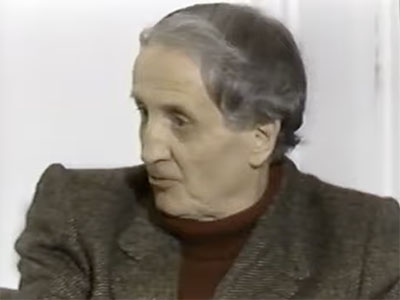 |
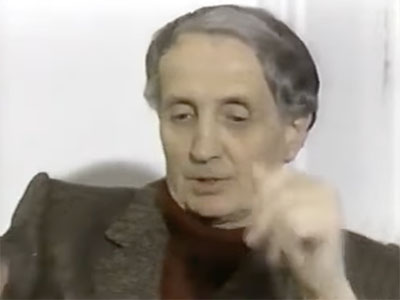 |
R. M. - - No? Anyways, let's move along. Of course, now you're back in Canada. You became the director of the Norman McKenzie Gallery in Regina.
R. B. - - I had had a year before that when I was at the U of T. The worst year I ever spent in my life. Absolutely the worst year. Overworked and underpaid. Low man on the totem pole. No respect. No nothing. Just terrible.
R. M. - - So you were glad to have that year finished. I know that you were painting quite a bit at that time. You were producing.
R. B. - - It was in that worst year of my life, when I got paid something like 4 thousand bucks a year, that I started to paint. And I can still recall doing a painting. And it was like going through a sound barrier, I suppose, for a pilot for the first time. I knew that I could paint for eternity in a non-figurative style. Something about it all made sense to me. And I must confess I've been painting non-figuratively since then. Steadily. Yeah.
R. M. - - And of course the interesting point in regard to your non-figurative paintings is that your reputation has been built totally on painting white paintings which have been changing. And they've been tremendous over the years. Now let's spend some time talking about Regina and of course the Regina 5. I think your period as the Director of Norman McKenzie Gallery was, I think, probably important to you, and also your association with the painters in Regina. Can you spend some time and talk about that?
R. B. - - So Regina was a fantastic experience for the few years I was out there as a director of a gallery. Where I left Toronto because obviously I didn't like the place. Regina offered me 500 bucks more a year. But I had never ever thought about directing a gallery. I'd never even made up a household budget, let alone a gallery budget, a public gallery budget. But it got me out.
When I left U of T, I remember, I think it was Professor Steven Vickers said to me, "well why are you going to Regina? There's nothing there." And I said, "well that's a good reason to go there." I didn't realize to what extent there is absolutely nothing there. I mean Regina is this "most unfortunate interruption of prairie space." But you can do a lot of things in a situation like that.
↑ ↓ ↑ ↓
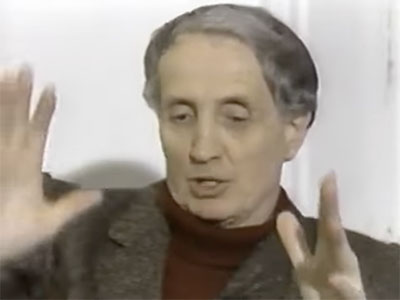 |
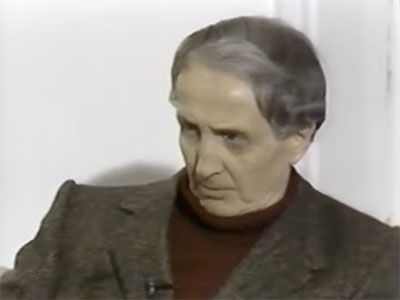 |
Coming in at that point as a non-figurative artist the other painters out there were highly suspicious of me. Everybody's suspicious of somebody coming in from Toronto to a place like Regina to take over a job of some importance, apparently, within the community. The other painters there were, I think, what Barnett Newman one time called “Half-assed Midwestern Abstractionists. But gradually, several of the painters there became interested in non-figurative art.
I began to bring in a fair number of shows relative to that kind of thing. For example, I gave Guido Molinari his first one-man exhibition, the first in a public gallery. The first person to give, on a figurative side, the Calgarian artist, at that point, Maxwell Bates an exhibition. I was the first person to give Ernest Lindner from Saskatoon in a public gallery an exhibition; the first person, I think, in a public gallery to show works by Greg Curnoe and Jack Chambers of London Ontario. And so on. So as a gallery director, in terms of exhibitions that I originated, I’m rather proud of that kind of activity which is certainly better than showing just what could be produced locally.
↑ ↓ ↑ ↓
...gradually, several of the painters there became interested in non-figurative art... I gave Guido Molinari his first one-man exhibition... Maxwell Bates... Ernest Lindner... Greg Curnoe and Jack Chambers...
But then I was also aware of the fact that I was in a situation where there were some painters in town who really wanted to move, to do something beyond a local scene. I mean Regina, Saskatchewan, that sort of thing, forget it, there's not very much there. And I brought, whenever I could, national exhibitions in. The National Gallery used to have bienallées in those days for example. I'd bring that in so the guys could see what the competition was in the rest of the country. Whether it was Vancouver, Montreal, Toronto or even Newfoundland with Chris Pratt. That was interesting.
I brought in exhibitions that I felt would be of value to local painters, some of them. As a result gradually around the gallery - and I think a public area has a sort of responsibility for the artist between us sphere of influence - some guys began to coalesce: Doug Morton, Ken Lochhead, Art Mackay, Ted Godwin, myself. And we became unfortunately known as the in-group. The galley did everything possible to support these guys. Everybody else was excluded because they didn't have the vision, the drive to go, to make it, try and hit it. I think all us out of that group have more or less survived one way or the other as painters in this country and the others havn’t. So I felt that was a very, very important thing.
And one year with the total arrogance that I had as a new gallery director, I invited the Canadian Museums Association to have its annual meeting in Regina. I didn't know what that meant. But nevertheless, “Okay guys.” When I announced they could all come, they were so happy and they all praised me and thanked me very much. I didn't realize it was because they didn't want to have to do it! you know, have the annual meeting. But! I decided to put on an exhibition of these painters, plus an architect, Cliff Wiens from Regina plus a sculptor, Wilfrum Niesson, for that particular show.
Now, I was told externally, that is: outside of my institution, “You can't do it Bloore.You can’t. You'll ruin yourself as a gallery director if you put on an exhibition of local talent." I said, “Well, I've made my commitment. On it goes." I was told by my boss, the Dean, Riddell, for the time, “Bloore, you can't do it. You've got to open it up. You've got to include other people. You can't do it." I said, "I've made my commitment. That's it it goes up that way.” Well the exhibition was a success. And as such, the local boys can recognize themselves. This is all I was doing. Right? And so. the National Gallery picked up a variation on it.
They wouldn't include an architect because architecture wasn't art in those days, for the National Gallery. And they wouldn't use the sculptor and I agreed. I didn't want him to go on because Wolfrum Neeson's contribution was not very good. It was bad, inexcusable. But the National Gallery made up this exhibition called Five Painters From Regina and ever since then we've been burdened with the term of the Regina Five. We tend to paint by numbers in Canada: "Painters 11," "Group of Seven” "Regina Five…” One guy in Toronto even announced himself as a group of one. I got a little worried about that one. So it was good. And that was the first time, I think, that the National Gallery ever put on an exhibition of a group of painters that were living artists.
R. M. - - Well it's good too from the standpoint of recognition. I mean you can't ignore the fact that it's good too, as an artist especially, to get that sort of recognition. And to be supported, you know, a group of of Canadian painters. I think that it's been important for a lot of artists in Canada, the aspect of showing as a group. "Painters 11” they did exactly the same. They formed as a group so that they could get some attention.
R. B. - - But we only had one exhibition, outside the one in Regina. No group of painters in this country got more mileage out of one exhibition than we did. One of the minor Miracles. But at that point in time the Canada, for example, I knew all the artists in this country on a first name basis. There were so few of us! Now I meet them all the time and I can't remember the names five minutes after I’ve met them. Now It was vastly different in those days to get to be known. If you had the will, the drive, the energy to do it, even from Regina. So Regina became, well, it was Montreal, Toronto, Regina. You want to believe that? We knocked Vancouver of the map. Nothing else counted. And constantly the people were coming to see us, what we were doing, once we had that show.
↑ ↓ ↑ ↓
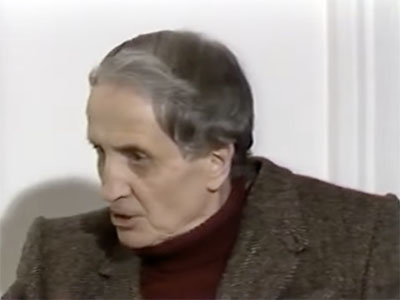 |
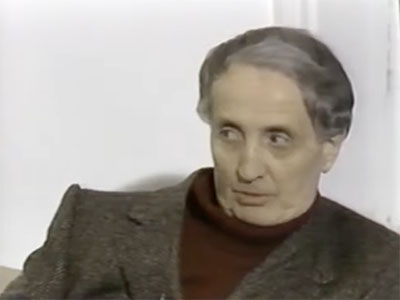 |
R. M. - - Well it obviously had meaning or you wouldn't have worked as a group as hard as you did.
R. B. - - But we didn't work as a group. We never thought of ourselves as a group! I mean, we might phone up and say, "let's have a board meeting down at the Queen’s Hotel" which means sit down and drink some beer. Starting about four o'clock or something like that. And one was always "off to a meeting" and the secretaries all knew. But that's how we were, also very very close families. We'd picnic together, party together, constantly. We used to get bored by it but on the other hand we couldn't find anybody else. It's interesting.
R. M. - - There was another point later. Of course now you’ve moved back to Ontario. And in 1966 you were teaching at York University. And in the mid 70s you started to teach painting. Can you talk a little bit about that? You were mentioning to me it was wasn't easy to be a teacher moving from a professor to teaching art. It was an interesting transition.
R. M. - - Yeah. All my training and experience had been behind a lectern. But it's fine. You can get up behind a lecture and drape your arms over it. You can look 200 students, 300, 400, in the eye collectively, as it were. You turned down the lights. You don't have to see. You can't see them anymore. You're flashing your slides on the screen and after 50 minutes you walk out. That’s your contact with the students. That's terrible!
Outside of that you could go read their essays, but that doesn't necessarily reveal very much because you never know who had really written the essay. I was finally persuaded, I guess in the mid ’70’s, to try teaching painting. While being a self-taught painter I thought this was slightly cheating, along the way. I recall the first year was terrible, and I thought I was a terrible teacher. But then I realized I had nine of a bunch of really neurotic students that particular first year. It was terrible! I'd go home get a bottle of wine drink it and forget about it.
I gradually got used to it. It's a much more intense and personal way of teaching. If you have 20 students in a class teaching studio work, you get to know them all in great detail and you become sort of Father Ron or Uncle Ron. And they come in and they talk about their other school problems, their boyfriend problems, their girlfriend problems, or triangles they're involved in, all that sort of thing. And you sit there and as well try to get them to learn something about the process of trying to make paintings. I always told them we're not teaching you how to create. I'm not teaching how to make art, but learn something about the process of trying to make art along the way.
↑ ↓ ↑ ↓
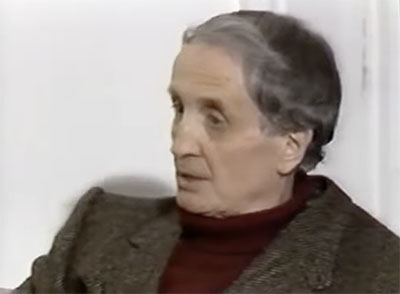 |
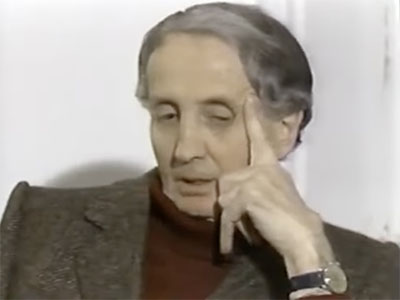 |
It's infinitely more difficult to teach someone to learn how to paint a little bit, than to stand up in front of a class and give a lecture, much more difficult. Because your teaching them a language. It's like they're in kindergarten learning the ABCs but they're at University. But that's fine. I mean, that's where they're at. And may we not teach too much painting or art history in high schools as far as I'm concerned. But they have got to start somewhere and gradulally they learn that they have a very very complex language to begin to learn. Every stroke, every colour, every shape, every form, all these things, all the relationships are difficult.
And to get them to see them sometimes… They'll say, “But my mother likes it." I said, "I don't care that your mother likes them. Why not? My mother didn't like what I was doing. She didn't know what I was doing. So what? I don't listen to these other people. I've been in the business since 1945. How long's your mother been an art critic?”
R. M. - - Yeah that's an interesting point. The other aspect of this too is that as a teacher you can't really prepare them for what being an artist, a professional artist, is all about. You were mentioning this to me the other day, about the hours in the studio, you and your work. That's really what it is to be an artist today, to be a successful artist today.
R. B. - - Well you can spend all the hours in the studio and still not be successful. Yeah many, I'll say, on Queen Street West in Toronto. You see a lot of kids and they're sort of trying to live the life of what they think the artist should be like. But you can't live the life of the artist on the street and be an artist. You got to be in that studio working eight, nine, ten hours a day. You got your stereo on, you got everything going, you don't have television. It's Spartan, it's dirty, it’s okay, but you're working. Then once in a while you surface and go out and have a few beers or what have you with other people trying to do the same thing. But you don't waste your time during the day.
R. M. - - It's hard work. That's really what you’re saying.
R. B. - - It is hard work. It is lonely work. That's something I always had to stress to my students, “Look. Right now you’re painting at a collectivity, in a class, 20, 25 of you around. But when you're out of here, and you're one of one, the old man isn't coming around to tell you, "come on, get up there and paint." Nobody else is telling you. You got to do it and ultimately you're your own critic, and if you're not tough on yourself, the world will be tough on you. It's as simple as that. You'll get nowhere. It takes work. And don't expect it to come, that you're going to be an instant genius at the age of 22.
You see so many of the exhibitions around in which you have 22, 23, 24 year olds, so-called artists who live in a society which is one of the finest, undoubtedly, in the world, as if they're Christ going up to Calvary to be tacked up on the cross. “The world is too much with me." And all they're trying to do is figure out how to get a few more bucks that they’ve already... you see, from the Canada Council. They've had no life experience. It takes a little while. Normally I've said to many of my students, fine, you know, let me know when you're 40. If you're still in the business then you've got a chance of survival. But also we warn them, if you've got a class of 20 maybe one or two might make it. The attrition rate is terrible. I wish the attrition rate was that high in architecture. We wouldn't have so many bad buildings. I can't think of another area in which the chances of being successful or so minimal.
↑ ↓ ↑ ↓
 |
 |
R. M. - - I'd like to take this opportunity to thank Ron Bloore for coming to Hamilton and giving us this wonderful exhibition and we'd also like to thank you for watching the interview. Thanks very much.